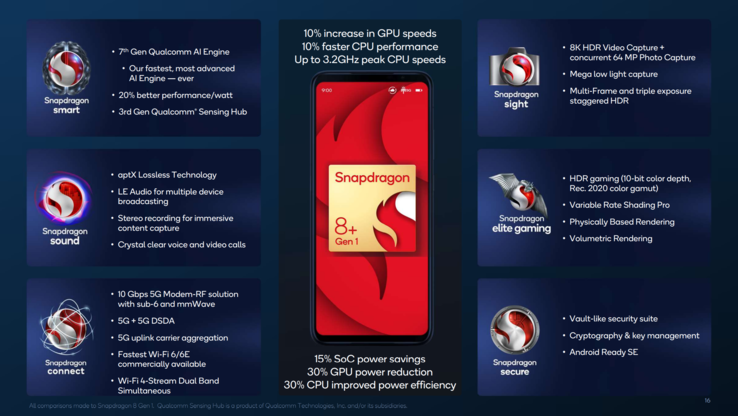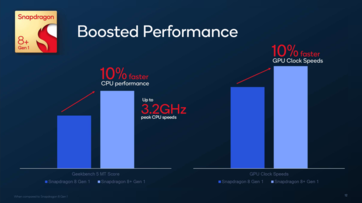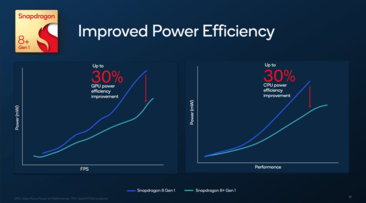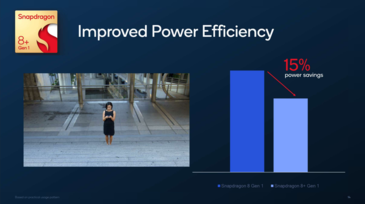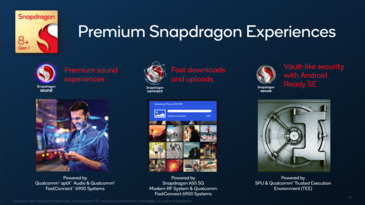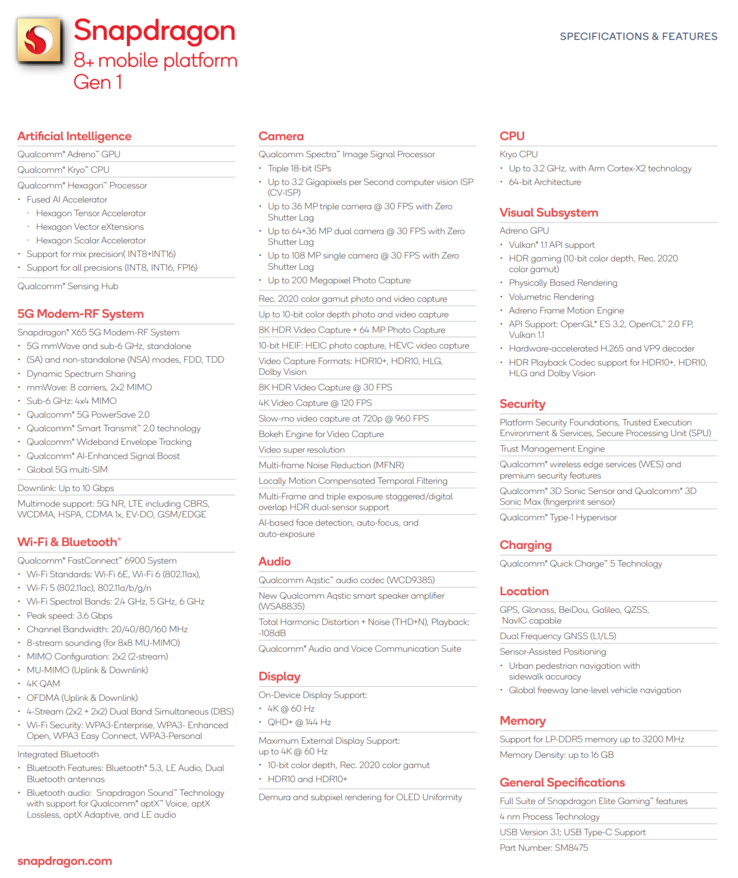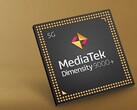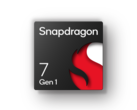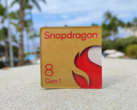It has now become customary for Qualcomm to release a incremental "Plus" upgrades to its flagship SoCs. We first saw the Snapdragon 8+ Gen 1 in action in a leaked Galaxy Z Flip4 Geekbench run. Today, Qualcomm is officially taking the wraps off the new premium SoC for Android smartphones.
According to Qualcomm, the Snapdragon 8+ Gen 1 powers premium Android experiences and the new iteration supposedly offers all-round improvements to CPU/GPU performance and power efficiency.
10% higher CPU and GPU clocks with up to 30% improved power efficiency
The new Snapdragon 8+ Gen 1 offers 10% faster CPU and GPU clocks. The peak Kryo CPU clock in the Prime ARM Cortex-X2 core can now attain 3.2 GHz compared to 3 GHz in the Snapdragon 8 Gen 1. The Adreno 730 GPU is also now 10% faster with features such as volumetric rendering for more realistic fog and smoke effects.
Despite the increase in clocks, Qualcomm claims up to a 30% improved power efficiency with the Kryo CPU and up to a 30% reduction in power consumption with the Adreno GPU.
The original Snapdragon 8 Gen 1 was criticised for high heat emissions. Hopefully, Qualcomm's new power efficiency claims can help with improved thermals. We hear that the move to TSMC 4 nm from Samsung for the 8+ Gen 1 could also play its part here.
20% more efficient AI with simultaneous bokeh, face tracking
Qualcomm also claimed improvements to the 8+ Gen 1's AI smarts. The SoC features a 7th gen Qualcomm AI Engine that allows functions such as simultaneous bokeh effects and face tracking during photography.
The AI function now apparently offers a 20% improvement in performance per Watt. There's also a 3rd Gen Qualcomm Sensing Hub that enables low-power AI without affecting battery life.
Enhanced mobile experiences
Qualcomm also stressed upon improvements to key mobile experiences including photography and audio. The Snapdragon 8+ Gen 1 offers a triple 18-bit Spectra ISP, which the company says can process 4,000x more camera data while enabling 8K HDR video recording and 64 MP camera captures. The 8+ Gen 1 is capable of 3.2 Gigapixels of captures per second and can snap and merge 30 images at once for improved low-light photos.
The 8+ Gen 1 is also capable of lossless audio streaming over Bluetooth via Snapdragon Sound. Snapdragon Sound includes aptX lossless and LE audio with the ability to last over 17 hours of music playback.
Snapdragon 8+ Gen 1 CPU benchmarks: Matches Dimensity 9000, 17% faster than 8 Gen 1 and Exynos 2200 in single-core while leading AnTuTu charts
Qualcomm provided some reference values for the Snapdragon 8+ Gen 1 during its presentation, so we will compare them below to get an overall perspective of the improvements that can be expected this generation.
In Geekbench 5 single-core, we see the 8+ Gen 1 to be 17% faster than an average 8 Gen 1, 888 Plus, and the Exynos 2200 while almost tying with reference MediaTek Dimensity 9000 values. In multi-core, the 8+ Gen 1 is more or less comparable to the average 8 Gen 1 and Dimensity 9000 while having a 15% lead over the Exynos 2200. The Apple A15 Bionic leads both tests unsurprisingly but the 8+ Gen 1 helps reduce the deltas perceivably compared to the 8 Gen 1.
The 8+ Gen 1 leads the AnTuTu charts with 14% and 37% faster performance over the 8 Gen 1 and Exynos 2200, respectively. The Dimensity 9000 reference is not too far behind, however. AnTuTu scores from the A15 Bionic are only provided for reference and are not comparable with the Android version.
Elsewhere, we find very good gains in web benchmarks that place the 8+ Gen 1 just behind the A15 Bionic.
| Jetstream 2 - 2.0 Total Score | |
| Average Apple A15 Bionic (173.5 - 189.9, n=8) | |
| Qualcomm Snapdragon 8+ Gen 1 Reference Values (Chrome v101.0.4951,41-64-Bit)) | |
| Average MediaTek Dimensity 9000 (127.2 - 148.6, n=3) | |
| Average Qualcomm Snapdragon 8 Gen 1 (72.8 - 134.6, n=16) | |
| Average Qualcomm Snapdragon 888 Plus 5G (75.9 - 125.4, n=4) | |
| Average HiSilicon Kirin 9000 (n=1) | |
| Average Samsung Exynos 2200 (13.8 - 107.4, n=4) | |
| Speedometer 2.0 - Result 2.0 | |
| Average Apple A15 Bionic (228 - 347, n=8) | |
| Qualcomm Snapdragon 8+ Gen 1 Reference Values (Chrome v101.0.4951,41-64-Bit)) | |
| Average MediaTek Dimensity 9000 (110 - 151, n=3) | |
| Average Samsung Exynos 2200 (105 - 137, n=4) | |
| Average Qualcomm Snapdragon 8 Gen 1 (64.4 - 129.3, n=16) | |
| Average Qualcomm Snapdragon 888 Plus 5G (79.8 - 114, n=3) | |
| Average HiSilicon Kirin 9000 (n=1) | |
Adreno 730: Up to 46% faster than A15 Bionic's GPU, signficant gains over the 8 Gen 1
The improved Adreno 730 GPU does seem to offer tangible benefits in GFXBench, particularly in Vulcan. The Adreno 730 now seems to be 44% faster in GFXBench Manhattan 3.0 Offscreen and 34% faster than the A15 Bionic's GPU. The Dimensity 9000 reference trails behind by 16% in this test.
GFXBench Manhattan 3.1 Offscreen seems to afford even higher improvements compared to the 8 Gen 1 and A15 Bionic's GPU. The Exynos 2200 trails the 8+ Gen 1 by 33% in this benchmark.
Going by Qualcomm's reference values, the Snapdragon 8+ Gen 1's performance indeed seems promising. We will have to wait for devices powered by the new SoC to test out key factors such as power consumption and real-world benefits.
It may be noted that there are no major differences in the specifications including the networking aspects apart from the above CPU and GPU performance and efficiency gains.
Devices powered by the Snapdragon 8+ Gen 1 are expected to become available from Q3 2022 from many OEMs including Asus ROG, Xiaomi BlackShark, Honor, iQOO, Lenovo, Motorola, Nubia, OnePlus, Oppo, Realme, RedMagic, Redmi, Xiaomi, Vivo, ZTE, and more.
Source(s)
Qualcomm Press Brief





